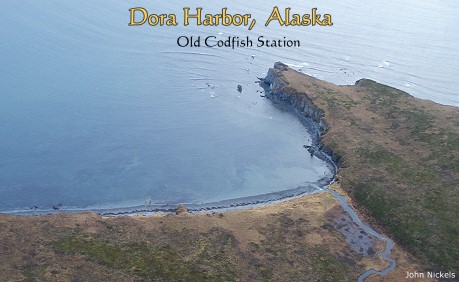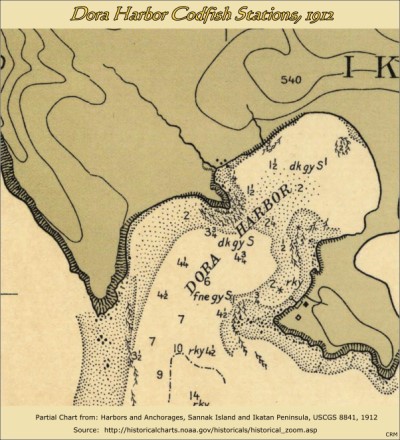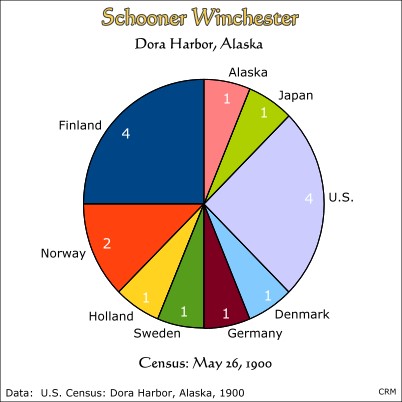


The above navigation chart shows the location of the two codfish stations in Dora Harbor. Dora Harbor is located on the southwestern side of the Ikatan Peninsula, Unimak Island, Alaska.
There were two codfish stations located in Dora Harbor. The above picture shows the traces of the one that was next to the stream, located on the north side of the harbor. The manager of the Union Fish station was Gunder Gundersen, from Norway, who later became the patriarch of the Gundersen family at Pauloff Harbor, Sanak Island. Most of his descendents now live in Sand Point, because Pauloff Harbor was abandoned in the early 1960s. A village did not grow up around the codfish stations here in Dora Harbor as happened in Sanak.
"The Dora Harbor, Unimak Island, stations of the Alaska Codfish Co. and the Union Fish Co. were established in 1897 and 1898, respectively. While they were quite productive the first two seasons, they have been steadily diminishing in importance ever since. The Sannak Island station men are transferred to these stations in the spring, after the cod have moved off into the deep water surrounding Sannak Island, and are brought back again in the fall when the fish have again returned to the shoal waters."1
An 1888 account of codfishing by schooner and at codfish stations can be read here.

The 1900 census has an entry for Dora Harbor but it is just for the Schooner Winchester that happened to be in port at the time. It had 16 men on board and sailed out of San Francisco. This schooner was clearly fishing for codfish. The captain was from Finland and the first mate was from Norway. The cook was Japanese and six other men were from northern Europe. One 22 year old man was from Alaska and it appears from the name, "Jupotnoi" that he was Aleut, probably from Unga because the Russian surname Chebetnoy is from there (now from Sand Point). Two of the fishermen on the boat were American teenagers from Ohio, aged 14 and 17 who state that they are "at school" when at home. One of the four American fishermen was a clerk while at home and the other was a sailor whose father was from Ireland.
This demographic data clearly shows the intense mixing of the ethnic and national populations on the codfish schooners at this time. The United States was undergoing a period of strong immigration from abroad and most of these immigrants were from northern Europe. As can be seen, these codfish schooners had little impact on the local Aleut villages because there was little interaction with them. The schooners were self-sufficient floating catcher-processors and only needed to come ashore occasionally for water. The established codfish stations on land had more impact on local villages because the crew lived ashore and the fishermen often took Aleut wives, as will be seen later in the data for Sanak Island where there were several codfish stations.
A Dora Harbor story: An elder in False Pass in 1980 reported that as a boy he lived in Ikatan. One day he decided to hike over the mountains to Dora Harbor to visit the men at the codfish station. He said that the men often had free time on their hands and to pass the time they would go out and hunt Bald Eagles to obtain their claws. The Alaska Territorial Legislature had placed a bounty of 50 cents on each Bald Eagle killed because they were blamed for declining salmon runs as they preyed on salmon while they spawned in shallow fresh water streams. The codfishermen had collected large round bundles of Bald Eagle claws and had them drying in the rafters of the bunkhouse which they would later turn in for a bounty.2 Over 128,000 Bald Eagles were thus killed in Alaska during the 36 years the bounty was in force.3 Fortunately, the Bald Eagle population has had a strong recovery and they are common again throughout the area wherever food and nesting conditions permit.
References:
1) Cobb, John Nathan; Pacific Cod Fisheries, "History of Alaska Shore Fishing Stations", Gov. Printing Office, 1916, Google Books.
2) Personal communication with John Hoblet, ca. 1980.
3) See article on Bald Eagles in Alaska here: http://www.sheldonmuseum.org/chilkatbaldeaglepreserve.htm